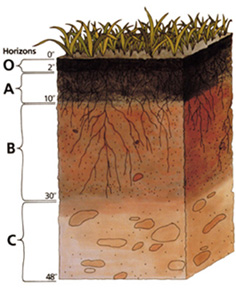 |
| A diagram showing the different soil horizons. USDA |
The new method of finding gold deposits through soil analysis has proven to be extremely effective. The soil is taken from the B horizon that is the layer below the A horizon the layer of soil at the surface containing organic matter. It works by finding soil that has anonymously high levels of gold or other elements. The average level of gold that is found in soil is about 5 ppb. This can be used as a background level of gold content anything above that is rated as an anomaly.
In practice soil tests are taken on a grid pattern; a good size to work with is a plot of land 400 by 400 m with samples taken every hundred meters. This will give you 16 points where you can take soil samples. The samples are then subject to an analysis checking for anonymously high levels of gold. Each analysis is noted that it's location on the grid with contour lines drawn between points of analysis. This is a quick way of finding places in the grid requiring further analytical work.
The size of the grid is entirely arbitrary where you can make it as large or small as you like by varying its spacing. Soil samples can be taken by digging through the A horizon with a shovel, or earth auger either hand or power operated. It is important to get a lower layer of soil below that which contains organic matter because A horizon soil can contain organic chemicals that can sequester different metals giving you a false reading.
When you find an area within your grid that indicates higher levels of specific metals you can include that area as a smaller grid where samples are taken every 10 m, and you can even refine this grid further until you actually pinpoint the location of a mineral deposit.
Soil analysis is a variation on geochemical anomaly mapping using soil as the matrix it is based on the theory that mineral deposits create an aura of metal ions in the surrounding soil that can be detected by an analysis. Geochemical anomaly mapping uses other matrices than soil including stream water, sediments, plants or other matter. This method also uses grid sampling is a way of finding anonymously high levels of metals beyond the background count.
The soil analysis method is the most accurate when it is possible in the field to use an X-Ray Fluorescence Spectrometer (XRF) for performing the analysis accuratly.

Thank you Sir, very useful information.
ReplyDeleteUsually on what kind of soil we can find more gold deposits?? Is that red, black or ...
ReplyDeleteBullion Exchanges is a trusted Bullion Shop established in New York City's Diamond District.
ReplyDeleteThey have a massive inventory of items like, precious metals that range from the gold & silver to the prestigious platinum and palladium.
They are offering an enormous selection of products appealing to 1st time investors and the established investors.
Thank you Geotek for the information. we have a licensed land for copper Gold cobalt manganese and iron ore deposit . We are looking for partners/financiers. Any interest?
ReplyDeletedoes it still exist? (mining land)
Delete